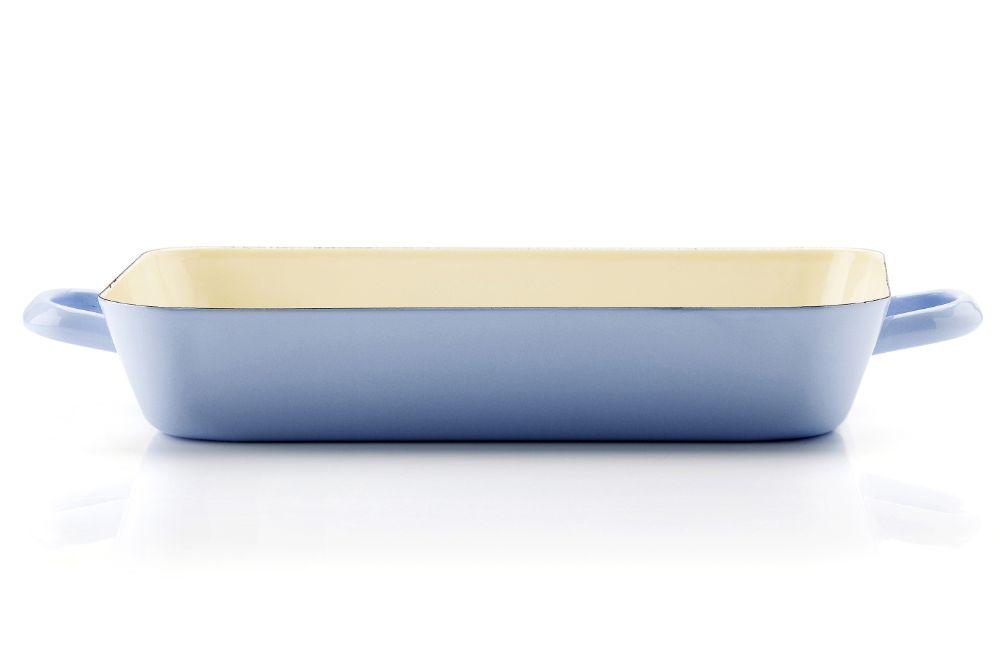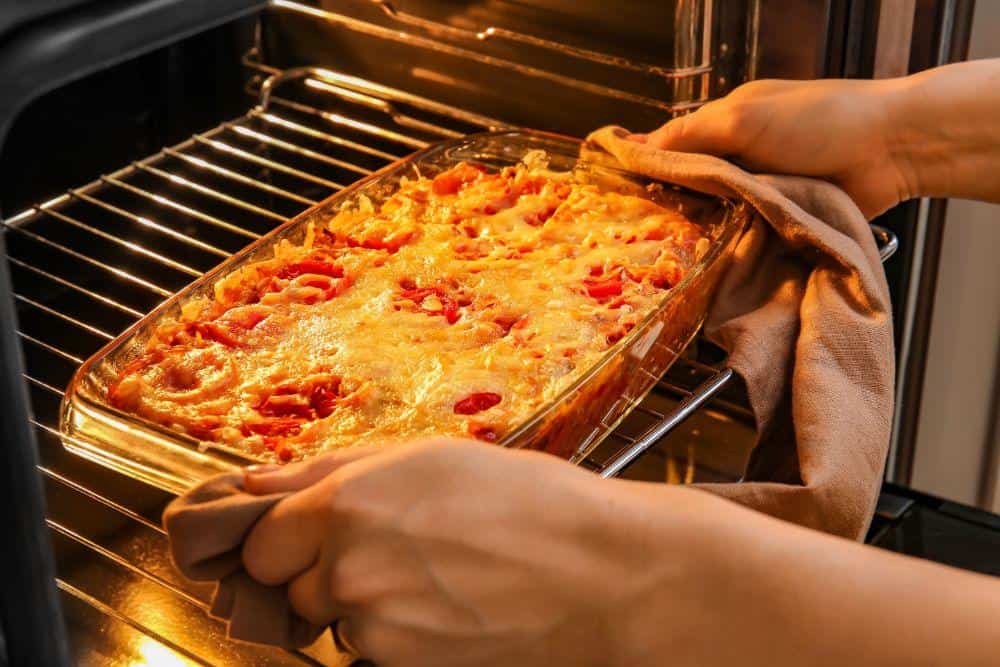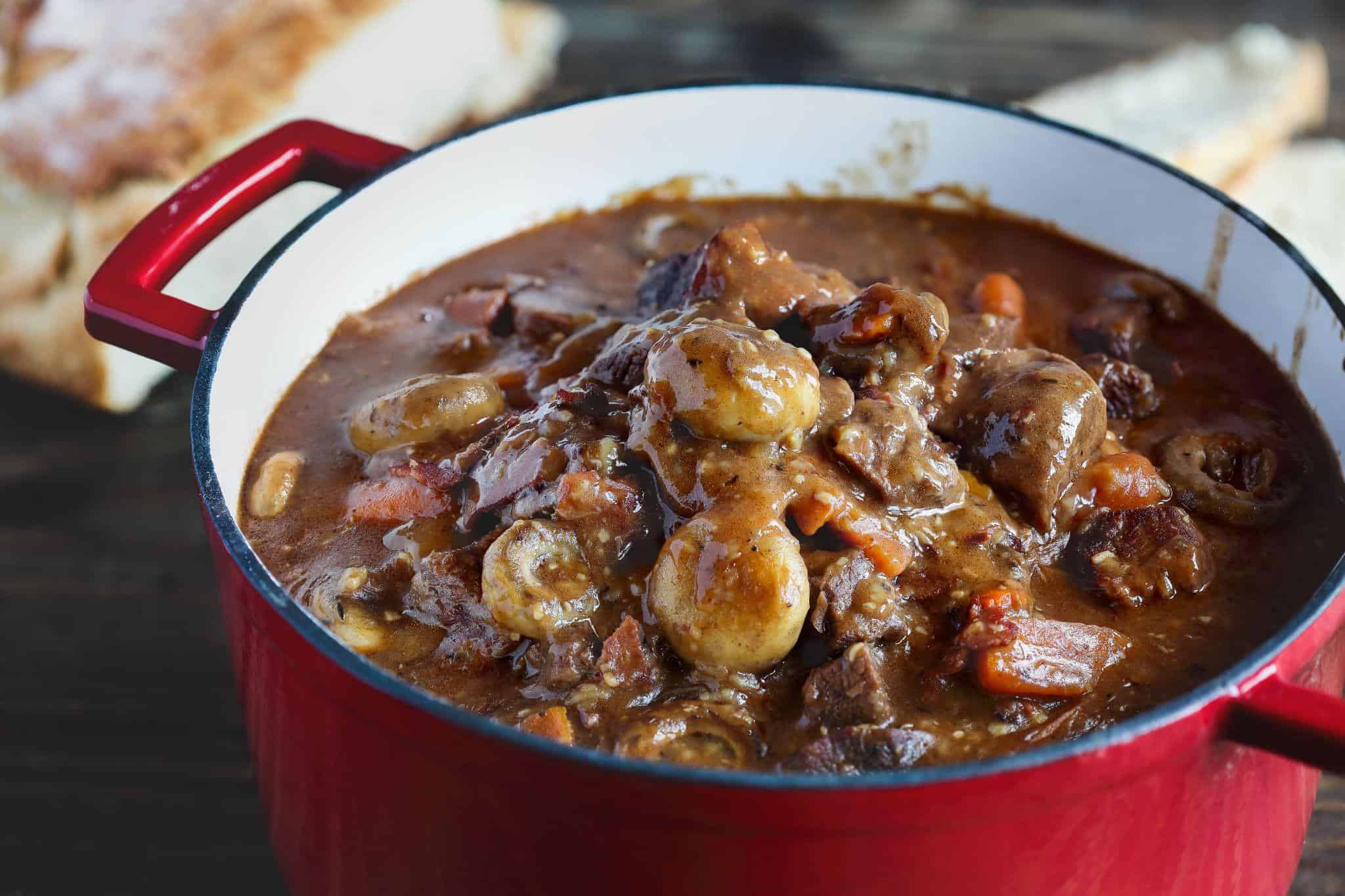Are you considering purchasing a casserole dish or a Dutch oven, but you’re not sure which is better? Or maybe your recipe calls for you to use a casserole dish, but you only have a Dutch oven. In either case, you’re probably wondering what the difference between the two is.
Both are large pots we use to make all kinds of foods, such as pasta, baked goods, and stews. Lots of people use the terms interchangeably. However, they refer to different things.
So casserole dish vs dutch oven: what’s the difference? We’re going to explain everything you need to know in this post. Let’s start with a brief overview of the uses of each.
A casserole dish is a large, deep pan used to cook food in the oven. You’ve probably also heard the term “casserole,” which refers to the type of food made in this dish. Casseroles are baked dishes combining several ingredients and a hearty sauce. And of course, a casserole dish is also something we use to serve food.
 A Classic Casserole Dish
A Classic Casserole Dish
Casserole dishes come with a tight-fitting lid, and they’re available in several materials. The most common include:
They’re also manufactured in many sizes, though you’re most likely to find a 9 x13 inch casserole dish. Most people consider this the standard size.
A Dutch oven is a pot that has thick walls and a well-fitting lid designed to keep steam inside. It’s made from enameled cast iron or seasoned cast iron, so they’re usually heavier than your average pot. This material is what makes Dutch ovens special: cast iron allows the pot to tolerate heat well, distribute heat evenly, and keep your food hot for a long time.
They’re incredibly versatile, too. You can use Dutch ovens to cook on both the stovetop and in your oven. Some people also use them to cook outdoors. You may hear this cookware called a French oven, although French ovens are slightly different.
Because they’re made to trap moisture, Dutch ovens are fantastic for moist-heat cooking methods. Cooks love them for making soups, sauces, stews, and braises. You can even cook an entire chicken in it.
Many people refer to casserole dishes and Dutch ovens interchangeably, but it’s critical to understand that they are different. Knowing which to use when you’re cooking is essential. It may mean the difference between success and failure.

So let’s take a look at what makes them similar--and what sets them apart.
At first glance, you’ll probably notice many similarities between a casserole dish and a Dutch oven.
Because of their similarities, it’s easy to see why people mistake the two. But if we take a closer look, there are several critical differences.
So what should you do if you want to make a Dutch oven recipe but you don’t have one?
The good news is that most things you make in a Dutch oven, you can also make in a casserole dish. Just be sure to look at the recipe’s heat requirements first. If it has heat requirements and your casserole dish isn’t cast iron, the recipe will be hard to replicate. Otherwise, go ahead.

A Finished Stew in a Dutch Oven
But what’s the best kind of casserole dish to use? Generally, whatever you have handy will work fine. The easiest option is to use a ceramic baking dish. This cookware typically has lids, which is a bonus.
But if you only have a glass dish, not to worry. Making a lid is easy to do. Just use some aluminum foil to seal the top to keep all the moisture where you want it: inside your dish.
You might find yourself in a situation where you have neither a casserole dish nor a Dutch oven. If so, you’ll need to think creatively about what you can use instead. You may also need to adjust your recipe depending on the method you choose.
The best substitute is some kind of cast iron cookware, like a skillet. A cast-iron skillet has a heavy bottom just like a Dutch oven. This feature helps it create slow and even heat. Because skillets don’t come with a lid, you’ll have to create your own with aluminum foil.
Although a cast iron skillet is a worthy substitute, it does have one downside. Skillets are much smaller than Dutch ovens, so you’re limited to making smaller quantities. Keep the smaller size in mind, as you may have to halve your recipe.
You can also use devices like slow cookers, air fryers, and Instant Pots. We’ll take a closer look at these appliances below.
Yes! There’s a reason they call Dutch ovens the original slow cooker, after all. If you prefer not to watch over a pot all day, using a slow cooker is an excellent substitute.
Models like the Crock-Pot are highly popular, relatively inexpensive, and serve much the same function. They work especially well for making braised dishes, soups, and stews. Just keep in mind you can’t sear meat in a slow cooker. You’ll need to complete this step in a separate pan.
To make your Dutch oven recipe in the slow cooker, the best practice is to use the same cook time. Set your Crock-Pot to high, and you’re good to go. If you have time, you may prefer to set it to low and double the cooking length.
Conversely, if you’re short on time, you might be wondering about using an Instant Pot instead. This handy gadget cooks food about thirty percent faster than traditional methods. It’s an electric pressure cooker that creates lots of steam, allowing it to get hotter than regular pots or pans. If you’re feeling the time crunch, harnessing the power of an Instant Pot is the way to go.
So what’s the best way to convert your recipe? Simply reduce your cooking time by a third and use slightly less liquid. If your dish calls for any dairy, add it at the end. Otherwise, you risk it curdling in the pot.
Plenty of home cooks use their Dutch oven for baking, and bread is no exception. It’s easy to bake a no-knead bread in, even if you’ve never done it before.
You can also use any oven-safe pot with a tight lid to make bread as long as the pot is safe for use in temperatures above 450F. Though using your casserole dish might come to mind, it’s best to use something else if you want the best results. Most are too short to bake bread in. As it begins to rise, it hits the baking sheet and goes flat. And who wants flat, sunken bread?
Instead, a stock pot is a better option, and you’re likely to have one on hand. Just make sure it’s at least four inches tall, and you should have enough room for the bread to rise.
While not their primary function, some people use Dutch ovens for frying. Because they’re heavy, Dutch ovens keep the oil hot--a requisite for achieving perfectly fried food. And the tall sides keep it from getting everywhere. If you need to fry now and then, a Dutch oven works well.
However, if you plan to do lots of frying, it’s not worth buying a Dutch oven for that purpose. Instead, you should invest in a tabletop fryer. Or if you want an even healthier option, go with the air fryer. An air fryer is much easier to use and achieves excellent results: a crispy outside with fewer calories and less fat.
Roasting pans are similar to casserole dishes in that they’re oven-safe. But the former comes with a rack, which promotes even heating and lets any drippings fall into the pan. Roasting pans are also usually larger and taller than casserole dishes.
Most people use them to cook large cuts of meat, so you likely reach for yours every November. Roasting pans are excellent for braising, but you can also use them to make casseroles.
Le Creuset is the gold standard of kitchenware, so it’s no surprise that you may be considering investing in one of their Dutch ovens. But you may have noticed that what the brand calls a casserole dish looks suspiciously like a Dutch oven.
So what is it? A casserole dish or a Dutch oven? Although Le Creuset calls this product a casserole dish, rest assured it’s a Dutch oven.
By now, you’ve seen that Dutch ovens are versatile cooking tools. You might even be considering buying one. But if you’re like most people, one thing is like to throw a wrench in your plans: their high cost.
This cookware is indeed expensive. The cast iron used to make the cookware is of the highest quality, and superior craftsmanship is required to make it durable. The best Dutch ovens run into the hundreds.
Despite the steep cost, they’re one hundred percent worth having. If you’re on the fence, here are some reasons you might want to invest in your own Dutch oven.
Home chefs reach for their Dutch ovens time and again because they do pretty much everything. From steaming, frying, and braising to even baking, you can make several recipes using just one pot. And being able to use them in both the oven and on the stovetop provides unmatched versatility.
If you’re purchasing kitchenware for a new home, investing in a Dutch oven may eliminate the need for other pieces. Having one also streamlines your cooking process since you cook everything in one pot. Plus, cleanup is much easier (though they are admittedly cumbersome, which is something to keep in mind).
If you want your food cooked perfectly every time: a Dutch oven is your best bet. Its construction allows it to provide high heat, which ensures that your meal reaches the ideal temperature. And because the tight lid keeps moisture in, you can achieve an even greater depth of flavor in your cooking.
Do you prepare food for a lot of people? The size of a Dutch oven is fantastic for feeding large families. It’s also excellent for anyone who likes to meal prep.
Finally, we have to mention how beautiful this cookware item is. There’s nothing like an eye-catching Dutch oven to enhance your kitchen’s aesthetic or even become a focal point. Whether you prefer a statement color or a more neutral tone, you can find a Dutch oven to suit your needs. You’ll probably want to leave your gorgeous pot sitting out for everyone to admire.
